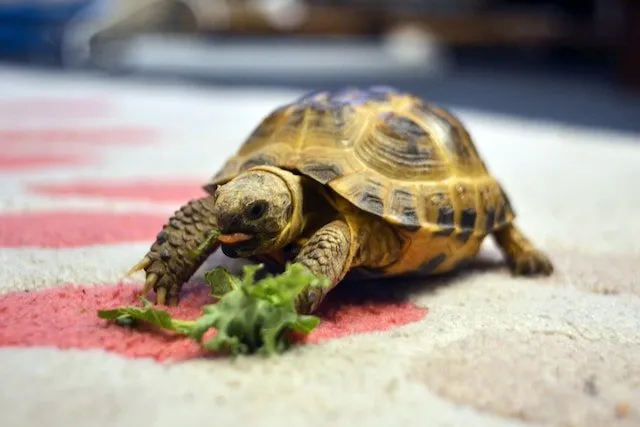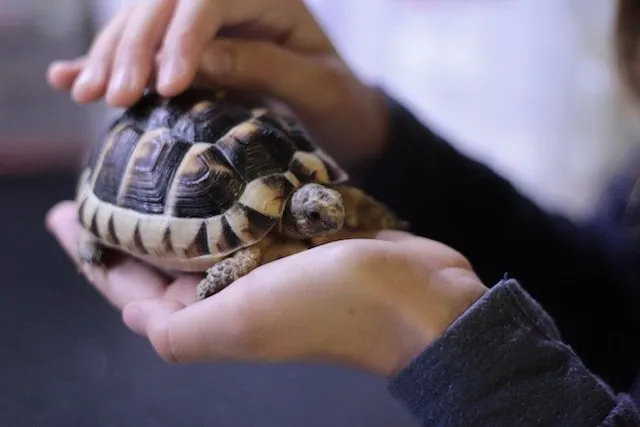As an Amazon Associate I earn from qualifying purchases.
Unravel the secrets of Russian tortoises’ taste buds as we embark on an exciting culinary adventure in the enchanting realm of reptilian cuisine. So what do Russian tortoises eat Prepare to be captivated as we explore the vibrant palette of flavors that tantalize a Russian tortoise’s appetite.
From leafy greens that nourish their shells to succulent cactus pads that hydrate their bodies, we’ll unlock the hidden treasures of their diet. Join us as we delve into the world of weeds, wildflowers, and occasional fruit treats, all curated to keep these charming creatures in the pink of health. So, gather ’round aspiring tortoise enthusiasts and devoted pet parents alike, for this blog post is sure to leave you hungry for knowledge about what makes a Russian tortoise’s diet both nutritious and delicious!
What Do Russian Tortoises Eat?
If you are a proud owner of these charming reptiles or considering bringing one into your home, it’s essential to know what they eat to ensure their well-being and longevity. Russian tortoises (Agrionemys horsfieldii) are small, hardy creatures native to Central Asia. Their diet primarily consists of a mix of vegetation, with specific foods playing a crucial role in their overall health and happiness. In this blog post, we will explore the delights of a Russian tortoise’s diet and the importance of each food item.
1. Leafy Greens:
Leafy greens form the cornerstone of a Russian tortoise’s diet. These include nutritious options such as romaine lettuce, collard greens, kale, and dandelion greens. These greens are rich in essential vitamins and minerals like calcium, vitamin A, and vitamin C. Calcium, in particular, is vital for a tortoise’s shell and bone health. Always remember to wash the greens thoroughly to remove any pesticides or residues that may be harmful to your pet.
2. Hay:
A steady supply of high-quality hay is essential for the digestive health of Russian tortoises. Timothy hay is an excellent option, providing essential fiber that aids in digestion and prevents constipation. The act of munching on hay also helps keep their beak trim and healthy.
3. Spineless Opuntia Cactus Pads:
These succulent cactus pads are a delicacy for Russian tortoises. Not only are they tasty, but they also provide much-needed hydration, especially during the hot summer months. Rich in water content and low in calories, Opuntia cactus pads offer a healthy treat that your tortoise will enjoy.
4. Weeds and Wildflowers:
In the wild, Russian tortoises feast on various weeds and wildflowers. You can replicate this natural diet by offering them treats such as clover, plantains, chickweed, and hibiscus flowers. Ensure that these plants are free from any chemicals or pesticides.
5. Fresh Fruits:
While fruits should be fed sparingly due to their higher sugar content, they do offer some nutritional benefits. Russian tortoises relish occasional treats like apples, strawberries, and watermelon. Make sure to chop the fruits into small, bite-sized pieces to prevent choking hazards.
6.Commercial Tortoise Pellets:
A well-balanced diet can be further supplemented with specially formulated commercial tortoise pellets. These pellets are designed to provide essential vitamins and minerals to ensure that your pet receives a complete diet.
Should I Keep Russian Tortoises As Pets?
Russian tortoises are great pets for various reasons, making them a delightful choice for reptile enthusiasts and animal lovers. These charming creatures have captured the hearts of many with their endearing personalities and unique traits. If you’re considering adding a new member to your family, here are several compelling reasons why Russian tortoises could be the perfect addition to your home.
1. Manageable Size:
Russian tortoises are relatively small compared to other pet reptiles, making them an ideal choice for individuals with limited living space. Their compact size allows them to comfortably reside in indoor enclosures or even outdoor pens, providing them with a suitable habitat.
2. Charming Personality:
Despite their slow movements, Russian tortoises have endearing personalities that can capture the hearts of their owners. They are known for their gentle and curious nature, making them enjoyable companions that are fascinating to observe.
3. Longevity:
If you’re considering getting a Russian tortoise, remember that they can live for a very long time, so it’s important to be prepared for a long-term commitment. When provided with proper care, they can live for several decades, becoming cherished members of the family for generations.
4. Low Maintenance:
Russian tortoises are relatively low-maintenance pets, making them a great option for individuals with busy lifestyles. Your care routine becomes straightforward once you have set up an appropriate habitat with proper lighting, temperature, and a balanced diet.
5. Herbivorous Diet:
Their herbivorous diet primarily consists of leafy greens, hay, and other plant-based foods. This simple diet is cost-effective and readily available, making it convenient for owners to provide their tortoises with nutritious meals.
6. Educational Experience:
Caring for a Russian tortoise can be an educational experience, especially for families with children. It provides an opportunity to teach kids about responsible pet ownership, wildlife conservation, and the natural behaviors of reptiles.
7. Quiet Companionship:
If you prefer a pet that won’t disrupt the tranquility of your home, Russian tortoises are an excellent choice. They are generally quiet creatures and won’t cause disturbances with constant vocalizations.
8. Aesthetically Pleasing Enclosures:
Designing and decorating their habitats can be a creative outlet for pet owners. Russian tortoise enclosures can be aesthetically pleasing, mimicking their natural environment and enhancing the overall ambiance of your living space.
How Do Russian Tortoises Help Our Ecosystem?
Russian tortoises play a significant role in their native ecosystems, and their presence contributes to the balance and health of the environment in several ways:
1. Seed Dispersal:
As herbivores, Russian tortoises consume various plants, including fruits and vegetables. They help disperse seeds through their feces, which aids in the germination and growth of new plants. This process supports biodiversity and helps maintain healthy vegetation in their habitat.
2. Habitat Engineering:
Through their burrowing behavior, Russian tortoises create shallow burrows in the ground. These burrows serve as shelters for various small animals, such as reptiles, insects, and small mammals, providing them protection from extreme temperatures and predators.
3. Plant Pruning and Grazing:
By feeding on vegetation, Russian tortoises can control plant growth and prevent overgrazing in certain areas. This helps maintain a balanced ecosystem and ensures that no single plant species dominates the landscape.
4. Prey for Predators:
Russian tortoises serve as prey for several natural predators, including birds of prey, foxes, and larger reptiles. By being part of the food chain, they contribute to the balance of predator-prey relationships within their ecosystem.
5. Soil Aeration:
The burrowing activity of Russian tortoises aerates the soil, which enhances nutrient circulation and improves soil quality. This benefits plant growth and the overall health of the surrounding vegetation.
6. Indicator Species:
Russian tortoises can act as indicator species, meaning their presence (or absence) can provide valuable information about the overall health and stability of their ecosystem. If their population declines, it may signal underlying environmental issues that need attention and conservation efforts.
7. Conservation Awareness:
Russian tortoises are an integral part of their native ecosystems, and their conservation status reflects the health of their habitat. By raising awareness about their importance in the ecosystem, efforts to protect and conserve these tortoises can also lead to the preservation of their natural environment and the numerous other species that rely on it.
Final Words
In conclusion, Russian tortoises are captivating pets that offer rewarding companionship and bring joy to many households. Their manageable size, charming personalities, and low-maintenance care make them an excellent choice for reptile enthusiasts of all levels. Beyond their role as pets, Russian tortoises also play a vital role in their native ecosystems. From seed dispersal to soil aeration and serving as an indicator species, they contribute to the balance and health of their environment.
You can also read:
1.What Do Red-Winged Blackbirds Eat? Exploring the Diverse Diet
2.What Do Red Squirrels Eat? Red Squirrels’ Culinary Adventures
3.What Do Purple Martins Eat? A Gourmet Guide to Their Diet
4.What Do Puffins Eat? A Culinary Adventure
Amazon and the Amazon logo are trademarks of Amazon.com, Inc, or its affiliates.



